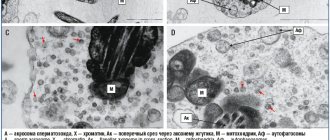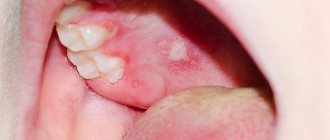Manifestations of the virus are characteristic blistering rashes on the mucous membranes and skin. After some time, small ulcers form in their place, then crusts. In the area where the rash should appear, burning and itching first occurs. Herpes is characterized by severe pain in the area of the rash.
The herpes virus spreads along the nerve endings and is not completely removed from the body even after a course of drug therapy. It is able to exist in an active and “sleeping” state.
Herpes simplex viruses types 2 and 1 are transmitted sexually and through contact, even when the symptoms of the disease in the carrier are not yet noticeable. In the early stages of infection, there are usually no symptoms at all, so diagnosis can only be made in the initial stages through laboratory testing. Primary infection with the virus most often occurs in childhood, even in preschool age.
In women, genital herpes usually appears on the labia and cervix, less often in the perineal area. In men, blisters appear on the skin and mucous membrane of the penis, as well as inside the urethra and rectum.
Classification of herpes
eight types of herpes have been identified for humans , each with its own name. This:
- herpes labialis (other names: herpes simplex virus type 1, HSV-1);
- genital herpes (also known as herpes simplex virus type 2, HSV-2);
- shingles or herpes zoster virus (scientifically called varicella zoster or varicella zoster virus, herpes type 3);
- Epstein-Barr virus (human herpes type 4, provocateur of mononucleosis);
- cytomegalovirus (herpes virus type 5);
- virus type 6 (infantile roseola provocateur);
- virus type 7 (causes infections in children, there is evidence of an association with chronic fatigue syndrome in adults);
- virus type 8 (there is evidence of a connection between the virus and the development of Kaposi's sarcoma).
Based on the mechanism of infection by viruses of this group, two large groups of infections can be distinguished:
- congenital (the virus enters the fetus in utero, often causing serious developmental defects and birth defects);
- acquired (the disease occurs after birth, both in childhood and in adulthood). After the virus enters the body, a primary infection clinic appears with fairly clear general manifestations. Against the background of decreased immune defense, secondary infections are possible - so-called relapses. They can manifest themselves with local and general symptoms. Source: Viruses of the herpes family and immunity. Kharlamova F.S., Egorova N.Yu., Guseva L.N., Guseva N.A., Novosad E.V., Chernova E.V., Uchaikin V.F. Children's infections, 2006. p. 3-10.
If we are talking about HSV type 1-2 infection, depending on the predominant damage to organs and tissues, several clinical forms of infection . This:
- damage to the oral mucosa (gingivitis, stomatitis, pharyngitis, tonsillitis);
- herpetic eye infection (keratitis, optic neuritis, iridocyclitis, conjunctivitis);
- skin rashes (rash on the wings of the nose, red border of the lips, skin of the face, body);
- lesions of the genitals (rashes on the penis or testicles, perineum in men, on the walls of the vagina, skin of the vulva, in the cervical canal area in women);
- herpetic damage to the nervous system (neuritis, encephalitis, meningitis, radiculitis);
- damage to internal organs;
- generalized forms of infection with hepatitis, pneumonia and the development of sepsis.
An atypical course of infection is also possible, both with relatively mild, barely noticeable symptoms on the skin and mucous membranes, and with severe manifestations - hemorrhagic, ulcerative, necrotic rashes.
The course of the infection can be mild, with a predominance of local symptoms, moderate, with local and general manifestations, and severe, including the development of dangerous complications.
HSV (HSV 1+2) IgM
Material for research: blood serum. Determination method: enzyme-linked immunosorbent assay (ELISA). The study is carried out using a test system produced by Vector Best (Russia). The presence of class M antibodies to herpes simplex virus types 1 and 2 (HSV, HSV) is a marker of primary infection with herpes simplex virus types 1 or 2. Antibodies to the herpes virus class M are the first antibodies formed after infection with the herpes virus. Ig M appears in the blood within 1-2 weeks from the onset of infection. In 10-30% of people with reactivation of an old infection, IgM antibodies may also be detected. Herpes infection is caused by two different but related forms of the Herpes simplex virus, known as herpes simplex virus type 1 (HSV-1), which most often causes “fever” on the lips, and herpes simplex virus type 2 (HSV-2). A common property of these viruses is their constant presence in the human body from the moment of infection. The virus can be in a “dormant” or active state and does not leave the body even under the influence of medications. The manifest manifestation of any herpes infection indicates a decrease in immunity. Herpes simplex virus type 1 is extremely common. Primary infection occurs, in most cases, in preschool age. In the future, the likelihood of infection drops sharply. A typical manifestation of infection is a “cold” on the lips. However, with oral contact, damage to the genitals is possible. Internal organs are affected only with a significant decrease in immunity. Genital herpes is characterized by the appearance of clusters of small, painful blisters on the genitals. Soon they burst, leaving small ulcers. In men, blisters most often form on the penis, sometimes in the urethra and rectum. In women, usually on the labia, less often in the cervix or anal area. After 1-3 weeks the disease seems to go away. But the virus penetrates the nerve fibers and continues to exist, hiding in the sacral part of the spinal cord. In many patients, genital herpes causes relapses of the disease. They occur with varying frequencies - from once a month to once every few years. They are provoked by other diseases, troubles, and even simply overheating in the sun. The genital herpes virus Herpes simplex type 2 primarily affects the integumentary tissue (epithelium) of the cervix in women and the penis in men, causing pain, itching, and the appearance of transparent blisters (vesicles) in place of which erosions/ulcers form. However, with oral contact, damage to the covering tissue of the lips and oral cavity is possible. In pregnant women: The virus can cross the placenta into the fetus and cause birth defects. Herpes can also cause spontaneous abortion or premature birth. But the danger of infection of the fetus is especially likely during childbirth, when passing through the cervix and vagina during primary or recurrent genital infection in the mother. Such infection increases the death rate of newborns or the development of severe brain or eye damage by 50%. Moreover, a certain risk of infection of the fetus exists even in cases where the mother does not have any symptoms of genital herpes at the time of birth. A child can become infected after birth if the mother or father has lesions in the mouth, or receive the virus through breast milk. Herpes simplex virus type II appears to be associated with cervical and vaginal cancer and increases susceptibility to HIV infection, which causes AIDS! In response to the introduction of HSV in the body, the production of specific immunoglobulins of class M (Ig M) begins. They can be detected in the blood 4-6 days after infection. They reach their maximum value at 15-20 days. From 10-14 days, the production of specific Ig G begins, somewhat later - IgA Ig M and Ig A do not remain in the human body for long (1-2 months), Ig G - throughout life (seropositivity). The detection of Ig M and/or a fourfold increase in the titers of specific immunoglobulins G (Ig G) in paired blood sera obtained from the patient with an interval of 10-12 days has diagnostic significance for primary infection with the herpes virus. Recurrent herpes usually occurs against the background of high Ig G levels, indicating constant antigenic stimulation of the body. The appearance of Ig M in such patients is a sign of exacerbation of the disease. HSV infection is part of the group of TORCH infections (the name is formed by the initial letters in the Latin names - Toxoplasma, Rubella, Cytomegalovirus, Herpes), which are considered potentially dangerous for the development of a child. It is most advisable to carry out laboratory testing for TORCH infections 2-3 months before the planned pregnancy. This makes it possible to take the necessary therapeutic or preventive measures, and serves as a point of comparison with the results of examinations during pregnancy. Indications for the purpose of analysis:
- Preparing for pregnancy (recommended for both partners);
- Signs of intrauterine infection, feto-placental insufficiency;
- State of immunosuppression in HIV infection;
- Differential diagnosis of urogenital infections;
- Blistering herpetimorphic rashes;
Preparation for the study: not required Units of measurement and conversion factors: The test is qualitative. The result is given in terms of “positive”, “negative”, “doubtful”. A positive result indicates:
- Acute herpetic infection;
- Reactivation of chronic herpes (rare).
Causes
The main cause of the disease is infection with one of the types of viruses listed above. However, clinical signs of herpes do not appear in all people infected with viruses. This largely depends on immunological reactivity and the influence of provoking factors. These include the following influences:
- frequent and prolonged overwork of the body;
- systemic hypothermia or overheating, excess UV radiation;
- physical and psycho-emotional stress;
- insomnia, sleep problems;
- sudden changes in climate, region of residence, time zone;
- colds, decreased immune defense.
The severity of manifestations and the form of the disease depend on age, general condition of the body, and associated factors.
Herpes type 7
Herpes virus type 7 is referred to as HHV-7 or HHV-7. Often this type of virus is combined with herpes virus type six. HCH-7 is a possible cause of chronic fatigue syndrome and cancer of lymphoid tissue.
Symptoms of herpes type 7
The following main symptoms of herpes type 7 are distinguished:
- Weakness due to lack of physical stress, increased nervousness;
- Light physical activity is accompanied by rapid fatigue;
- Excessive increase in suspiciousness;
- Chronic depressive conditions;
- Sleep disorders (insomnia);
- Long-term (up to 6 months in a row) subfebrile body temperature;
- Enlarged lymph nodes.
Anamnesis and physical examination methods are complemented by laboratory tests:
- Polymerase chain reaction (PCR) - detection of the genetic material of the virus,
- Enzyme-linked immunosorbent assay (ELISA) – determination of IgG titers;
- Immunogram with determination of subpopulations of T- and B-lymphocytes (decrease in the content of natural killer cells and increase in circulating immune complexes).
Treatment of herpes virus type 7 consists of antiviral therapy aimed at strengthening the immune system. Preventive measures have not been developed.
How is herpes transmitted?
The main source of infection is the carrier of the virus, which is contagious both during carriage and during exacerbation. Source: Features of herpes viruses. Peradze Kh.D., Sukhoruk A.A. Pediatrician, 2010. p. 78-80. The virus is found in semen, saliva, vaginal secretions, blood, and the contents of vesicles. All people are susceptible to infection; the risk of transmission of infection increases in the presence of microdamages and injuries to the mucous membranes and skin. Most often, people become infected with HSV types 1 and 2.
Herpes simplex type 1 is transmitted through saliva (by kissing, coughing, sneezing, or sharing utensils). The transmission mechanism is aerosol (with particles of mucus and saliva from the nasopharynx), contact and household (from the surface of the skin, objects).
The second type of herpes is transmitted through intimate intimacy, through contact and household contact, during pregnancy and during childbirth.
Herpes type 3
The third type of herpes virus is the varicella zoster virus or herpes zoster virus (VZO-OG, Human herpesvirus 3, HHV-3, Varicella-zoster (VZV). The herpes zoster virus enters the body of a susceptible person through airborne droplets or household contact. Infection causes chickenpox in childhood. After contracting chickenpox, the child remains a lifelong carrier of the VZV virus. The virus is localized in the tissues of the nervous system. Recurrences of herpes zoster in adults cause a disease called herpes zoster (Zoster).
Symptoms of VZO-OG in childhood are pronounced. Usually the disease has a benign course (mostly complete recovery). The acute phase lasts up to two months.
The main symptoms of chickenpox:
- Severe skin itching;
- High body temperature;
- Extensive skin rashes (vesicles).
The localization of the rash coincides with the projection of the nerve trunks on the skin. After the disappearance of clinical symptoms, the virus becomes inactive and localizes in the nervous tissue. Carrying the herpes zoster virus lasts for life. Relapses can occur in people when the protective properties of the immune system decrease. In the classical view of epidemiology, zoster recurs and manifests itself clinically in people over fifty years of age. In recent years, this pattern has been broken. Recurrence of the disease caused by herpes zoster is called herpes zoster.
The main symptoms of herpes zoster:
- Severe pain along the nerve trunks for 3-12 days;
- Hyperthermia (increased general body temperature);
- Swelling and redness of the skin, after 1-3 days – rashes in the form of vesicles;
- After 2-3 weeks, the disease ends with recovery after scarring of the crusts at the site of the vesicles.
Complications of herpetic lichen are ganglionitis (inflammation of a nerve ganglion) or ganglioneuritis (inflammation of several nerve ganglia). Diseases are manifested by allergies, skin ulcers, conjunctivitis and eczema. Regular relapses of herpetic lichen are characteristic of immunodeficiencies.
Treatment of diseases caused by herpes type 3 (varicella in children and herpes zoster in adults) is carried out in a hospital or on an outpatient basis after differential diagnosis and determination of the individual characteristics of the pathogenesis of the patient.
Symptoms
The incubation period from the moment the virus enters the body until the first manifestations can last from 2 to 14 days. It is often difficult to accurately determine the time of infection, since the infection does not always appear.
If the skin is affected, small rashes appear on the wings of the nose, the red border of the lips or around the mouth, in the buttocks, on the torso, and in the perineum. The rash looks like small blisters, which are grouped into a plaque, the base of which is swollen and red. The bubbles quickly open, forming honey-yellow crusts, which then fall off without scars. Sometimes quite large drainage blisters form, the contents of which can fester, oozing occurs, and a secondary microbial infection may occur. The blisters can cause a burning sensation, itching, pain, the general condition suffers slightly, and sometimes the regional lymph nodes react. The rash goes away within a week. Against the background of immunodeficiency, herpes can be widespread, organs and the nervous system are affected, intoxication and fever are possible.
When herpes recurs on the skin in the area of the rash, itching and tingling, discomfort in the area where blisters appear, initially appear.
With the genital form of herpes, grouped blisters appear on the skin and mucous membranes of the genital organs, which are painful, have a red base, and are very itchy. The inguinal lymph nodes react to the rash. the frequency of exacerbations depends on the general condition of the body. Source: Some information about the morphology of herpes viruses and their properties. Lutsenko M.T., Gorikov I.N. Bulletin of physiology and pathology of breathing No. 38, 2010. p. 74-77.
When the eyes are affected, keratitis or conjunctivitis occurs with severe burning, pain, and decreased vision in one eye.
In patients with skin pathologies, eczema herpetiformis is possible. It is accompanied by intoxication, high fever, and the appearance of vesicular rashes throughout the body, which can merge with each other; inside they are filled with hemorrhagic contents. The blisters then form a crust and there is a high risk of secondary infection.
Herpes type 5
Herpes virus type 5 is cytomegalovirus (CMV) or HHV-5 (Human herpesvirus 5). Clinical symptoms of cytomegalovirus infection rarely develop. Basically, there is a sluggish virus carriage. Infection is airborne, contact (kissing, sexual intercourse, blood transfusion, in utero, through breast milk). Infection is confirmed by the detection of giant cells - cytomegal cells - in human blood. The clinical picture develops with weakened immunity. The incubation period is up to 60 days.
Symptoms of cytomegalovirus infection resemble a cold:
- High temperature, fatigue;
- Pain syndrome (head, joints, throat);
- Unlike mononucleosis, there is no inflammation of the tonsils and enlargement of regional lymph nodes;
- Damage to the kidneys, liver, spleen, pancreas, central nervous system, eyes.
Cytomegalovirus can have a significant negative impact on the course of pregnancy. It penetrates the placental barrier, causing infection and deformities in the fetus. Currently, this is the most common cause of neonatal pathologies, and sometimes the death of newborn children.
A child with congenital cytomegalovirus infection may suffer from:
- Underdevelopment of the brain;
- Damage to the organs of hearing and vision;
- Delayed general development;
- Inflammatory phenomena in the respiratory and digestive organs;
- Skin rashes.
Diagnosis of herpes type 5
CMV is diagnosed based on:
- Instrumental methods - ultrasound study of blood flow in the vessels of the umbilical cord and uterus, measurement of heart rate (heart rate), determination of oligohydramnios, delays in fetal development, pathologies of its internal organs;
- Laboratory methods - detection of cells by electron microscopy, PCR analysis, serological studies to detect antibodies to CMV.
Treatment of a pregnant woman and the advisability of continuing the pregnancy are determined by the doctor based on a series of examinations. Primary infection after conception is a direct indication for artificial termination of pregnancy. General strengthening medications, immunocorrection and symptomatic therapy are prescribed as the main therapy.
Diagnosis of HSV and other forms of infection
A preliminary diagnosis can be made based on the typical manifestations of the infection, but a number of herpes tests can confirm the presence of the virus. Laboratory methods for detecting herpes infection include:
- general clinical blood test: the size of erythrocytes, the level of leukocytes are assessed (leukopenia is typical), against the background of a secondary infection, an increase in leukocytes is possible (neutrophilic leukocytosis), ESR is accelerated or normal.
- urine test - changes are possible in case of damage to the kidneys or urinary tract; in other locations, the analysis will be within normal limits;
- blood biochemistry does not have significant deviations; in severe forms, an increase in ALT and AST enzymes is possible;
- ELISA blood test - determines an increase in the titer of IgG antibodies, which indicates infection with the virus. With a fresh infection, IgM antibodies also appear;
- carrying out PCR to detect the DNA of the virus itself in the blood, contents of vesicles or other biological fluids.
Interpretation of tests for antibodies to herpes simplex virus types 1 and 2
• IgG is elevated in chronic herpes infection. If antibodies to herpes IgG increase by more than 30% when repeated testing after a time interval of 10 days, you can think about activation of the infection. If the titer of IgG antibodies to the herpes virus decreases during repeated studies, this indicates the success of treatment and the “extinction” of the infection.
Elevated IgG antibodies to herpes may indicate an intrauterine infection or the likelihood of its development. If the study was first performed during pregnancy, then it is not worth judging the probability until repeated studies are carried out. If IgG antibodies to herpes simplex virus types 2 and 1 were detected in the blood before pregnancy, then the likelihood of intrauterine infection is low.
• IgA appears in the blood 14 or more days after infection with the herpes virus and is not critical in diagnosis.
• IgM class - the first antibodies that appear after infection with herpes simplex virus types 2 and 1 within two weeks. A positive test result makes one think about an acute herpetic infection or the activation of a chronic one. In the latter case, IgM does not always appear in the blood serum; here the concentration of IgG antibodies to herpes is of greater importance.
A negative test result may indicate no infection. However, the same test result occurs in the first days of herpes infection or with a chronic inactive infection.
Herpes treatment regimen
If mild symptoms of HSV are detected, treatment can be carried out at home; for generalized forms, hospitalization is necessary. There are two treatment regimens for treating exacerbations. In the first, which is used on demand, various herpes treatments are used at the first manifestations, even before the appearance of blistering rashes. It is recommended to take loading doses of herpes medications in tablets throughout the day. This allows you to prevent relapse without the appearance of typical skin rashesSource: Approaches to immunotherapy for recurrent herpes simplex. Shulzhenko A.E., Zuikova I.N. Science of life and health, 2014. p. 130-131.
The second regimen is a long course of anti-relapse treatment if herpes worsens every 1-2 months or more often. Oral medications for herpes are indicated for daily use for up to a year. During this period, immune function, which is responsible for suppressing infection, is restored.
The use of local remedies - cream, ointment for herpes on the area of the rash, has a very limited effect.
Etiotropic therapy is supplemented with drugs to stimulate the immune system and vitamin preparations.
To prevent frequent relapses, a herpes vaccine is necessary. It is administered outside the period of exacerbation according to the scheme and protects against severe and complicated forms. Source: Modern prospects for the treatment of genital herpes. Khryanin A.A., Reshetnikov O.V. Medical Council, 2022. p. 80-84.
Herpes type 6 in adults
Herpes virus type 6 is referred to as HHV-6 or HHV-6. This is the common name for the human herpes virus of two subtypes homologous to each other. In adults, the HCH-6A subtype is active as one of the provocateurs of the development of multiple sclerosis.
Multiple sclerosis is a multifactorial autoimmune disease with a predominant lesion of the central nervous system, which is diagnosed in people 20 years of age and older, and very rarely in other age groups.
The most important facts about herpes virus type 6:
- The presence of this particular type of herpes virus in the etiopathogenesis of multiple sclerosis has been proven;
- The clinical picture of MS is chronic inflammation of nerve tissues, including the myelin layer of the brain - demyelination, which is accompanied by degenerative processes in nerve tissues;
- Without treatment, multiple sclerosis inevitably leads to disability, social and psychological isolation of the patient.
There are four types of multiple sclerosis:
- Primary progressive multiple sclerosis. The patient’s condition is characterized by a steady deterioration, a short-term subsidence of the process is possible, and then a rapid relapse;
- Secondary progressive multiple sclerosis. Characteristic periods of exacerbation after the first wave of the disease;
- Remitting-progressive multiple sclerosis (Latin remitto - weaken). At a certain point, the signs of the disease disappear, and then there is a sharp return and increase in symptoms;
- Relapsing-remitting multiple sclerosis. It is characterized by periods of disappearance and recovery of symptoms; a long-term stable condition of the patient is observed without visible signs of deterioration in well-being.
Symptoms of herpes type 6
Early symptoms of multiple sclerosis:
- Fatigue, depression;
- Unsteadiness of gait, poor coordination of movements;
- Change in sensitivity (temperature, vibration and tactile).
The main symptoms of MS, which characterize significant changes in the body, in addition to early signs that usually persist and worsen:
- Cognitive disorders, rapid mood swings;
- Visual disturbances (defocus in the form of double vision, decreased visual acuity);
- Difficulties with articulation when speaking (unusual pronunciation of words);
- Dysphagia (impaired swallowing);
- Spasms and cramps;
- Deterioration of sensitivity (lack of pain response);
- Fecal and urinary incontinence, constipation and diarrhea;
- Erectile disfunction.
The nature and degree of manifestation of symptoms of multiple sclerosis are varied, which is associated with the unpredictability of areas of damage to nervous tissue.
Treatment of herpes type 6
For the treatment of multiple sclerosis the following is used:
- Corticosteroids (methylprednisolone, dexamethasone and others);
- Antioxidants, antiplatelet agents, angioprotectors;
- Proteolysis inhibitors;
- Plasmapheresis with drugs;
- Immunomodulators, for example Copaxone;
- Stimulators of interferon production (Betaferon, Rebif, Avonesk);
- Immunoglobulins intravenously, for example, Sandoglobin.
Drugs from other groups may be indicated, depending on the stage and form of the disease. Symptomatic therapy and medical and social rehabilitation of patients with multiple sclerosis prevents the development of complications.
Prevention
Particular importance in preventing exacerbations is given to maintaining a healthy lifestyle. A rational, healthy diet, moderate physical activity, treatment of all infections, concomitant pathologies, elimination of stress and hypothermia are necessary.
When rashes appear, no special measures are taken; it is important to provide the patient with separate dishes and hygiene items, and avoid close contact and kissing until complete recovery. For HSV type 2, the use of condoms is important.
Taking medications for herpes or vaccination can reduce the risk of exacerbations. Source: Prospects for vaccine prevention of herpes simplex. Isakov V.A., Isakov D.V. Bulletin of Hematology No. 3, 2022. p. 4-10.
Sources:
- Features of herpes viruses. Peradze Kh.D., Sukhoruk A.A. Pediatrician, 2010. p. 78-80
- Viruses of the herpes family and immunity. Kharlamova F.S., Egorova N.Yu., Guseva L.N., Guseva N.A., Novosad E.V., Chernova E.V., Uchaikin V.F. Children's infections, 2006. p. 3-10
- Prospects for vaccine prevention of herpes simplex. Isakov V.A., Isakov D.V. Bulletin of Hematology No. 3, 2022. p. 4-10
- Approaches to immunotherapy for recurrent herpes simplex. Shulzhenko A.E., Zuikova I.N. Science of life and health, 2014. p. 130-131
- Modern prospects for the treatment of genital herpes. Khryanin A.A., Reshetnikov O.V. Medical Council, 2022. p. 80-84
- Some information about the morphology of herpes viruses and their properties. Lutsenko M.T., Gorikov I.N. Bulletin of physiology and pathology of breathing No. 38, 2010. p. 74-77
Herpes type 8
Herpes virus type eight is designated as HHV-8 or HHV-8. This pathogen infects lymphocytes, moreover, it can remain latent in the body of healthy people for a long time. Herpes virus type 8 is transmitted by contact, during organ transplantation, through the placenta from mother to fetus, during pregnancy and during childbirth, and during the movement of the fetus through the birth canal. The disease is activated due to radiation therapy.
Symptoms of herpes type 8
Symptoms of herpes type 8 should be considered, given that HCH-8 causes a number of cancers:
- Kaposi's sarcoma;
- Primary lymphoma;
- Castleman's disease.
Kaposi's sarcoma
Kaposi's sarcoma is an oncological disease characterized by the formation of multiple tumors due to malignant degeneration of blood vessels.
Kaposi's sarcoma is localized to:
- Skin;
- Mucous membranes;
- Lymph nodes;
- Internal organs.
There are four types of Kaposi's sarcoma:
- Classic type. Occurs in elderly and senile men. The disease manifests itself on the skin of the hands, on the ears and cheeks, on the forehead and mucous membrane of the mouth, as well as on the genitals in the form of multiple symmetrical spots, nodules and plaques;
- Endemic type. Widespread only in Africa;
- Immunosuppressive type. Develops while taking immunosuppressants;
- Epidemic type. Develops as a complication in AIDS patients. Characterized by a very rapid course of pathogenesis with damage to the lymph nodes and internal organs.
Treatment of Kaposi's sarcoma: surgical method (cryotherapy), medication (administration of interferon, cytostatics, antitumor and antiviral drugs), radiation therapy.
Primary lymphoma
This is an oncological disease with a predominant lesion of the serous membranes, which is characterized by the accumulation of fluids containing tumor cells in the body cavities. Primary lymphoma is treated only with chemotherapy.
Castleman disease
Manifested by enlarged lymph nodes (subclavian and mesenteric, as well as in the lungs and neck). There are three types of Castleman disease: hyaline-vascular, plasma cell and multifocal. Treatment of the disease is surgical or with radiation therapy.
Author of the article:
Kuzmina Vera Valerievna |
Endocrinologist, nutritionist Education: Diploma of the Russian State Medical University named after. N.I. Pirogov, specialty “General Medicine” (2004). Residency at the Moscow State Medical and Dental University, diploma in Endocrinology (2006). Our authors







